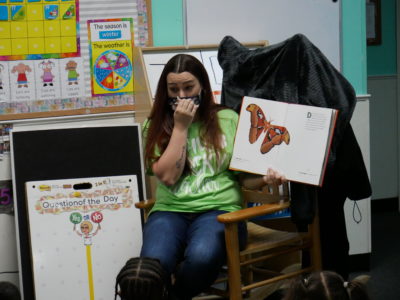

|
|
North Carolina is home to one of the most famous early childhood research studies, the Carolina Abecedarian Project, which for decades has affected research, policy, and public knowledge about the importance of early childhood experiences.
A paper published last week in Early Childhood Research Quarterly revisits the project, but centers an aspect of children’s lives that the study often left out: race.
The researchers behind the paper, Iheoma Iruka and Elizabeth Pungello Bruno, want to move early childhood research, policy, and practice ahead by explaining what is missed when race and racism are ignored.
“By being color-blind and ignoring race, you’re ignoring racism,” Bruno, president of the Brady Educational Foundation and former investigator on the Abecedarian Project, said in an interview. “You’re ignoring a huge factor that’s impacting the community, not just individual interactions, but the structural policies that are leading to inequities.”
The “color-blind” approach also misses the assets that Black children and families bring to the classroom, Iruka added.
“It also just erases not just the bad stuff but also the good stuff about being from particular groups,” Iruka said. “It erases your language, it erases your family, it erases your community, it erases your resilience.”
A study that ‘changed the world’
The Abecedarian project started in the 1970s when 111 children in Chapel Hill were selected based on factors associated with poor cognitive outcomes, such as low income and parental education levels. Some of the children were placed in a control group. The others went into a treatment group that received a center-based early educational intervention starting when they were 6 weeks old and lasting until they were 5 years old. They attended the program six to eight hours per day, five days per week, 50 weeks per year.
The Frank Porter Graham Child Development Institute researchers measured cognitive outcomes throughout the five-year treatment period, as well as in follow-up studies in elementary school, adolescence, young adulthood, and mid-adulthood. The children in the treatment group scored significantly higher than the control group over the years. Other measures of academic achievement, special education placement, employment, civic engagement, and mental and physical health later in life were all significantly better for the children in the treatment group.
The study has influenced the field enormously, said Kenneth Dodge, a Duke University professor of public policy, psychology, and neuroscience, former director of the Center for Child and Family Policy, and founder of Family Connects International.
When the project started, there were skeptics who doubted that early intervention could make a difference in outcomes, because of either biological or social factors, Dodge said.
“And here these folks came along and show you can have a positive impact,” Dodge said. “That changed the world. It expanded more research in the area, more innovation.”
Among the programs and policy informed by the study are the HighScope Perry Preschool Project, the Heckman Curve, and the Educare Learning Network, according to the new paper. Advocates of Head Start also used the study’s findings to sustain federal funding, Dodge said.
The paper lifts up the important contributions of the Abecedarian project and outlines its strengths as well as its limitations.
“I don’t think they’re saying that this investigation should be … dismantled,” Dodge said. “Rather, we need to put it into context … I think that’s the positive conversation that they are having and wanting all of us to have.”
‘Color-blind’ limitations
Though race was not one of the criteria for the study, 98% of the participants were Black.
“I remember consciously thinking … we want to focus on income, because we don’t want to imply that for some reason, Black children aren’t going to be able to achieve,” said Bruno, who worked on the Abecedarian project’s follow-up study that assessed the participants when they were 21 years old.
Yet not factoring in the ways racism and discrimination were affecting families ignores the living conditions of Black families at the time of the study, the researchers said. The Civil Rights Act had only recently been passed, in 1964, and in 1970, Black families’ median income was 56% of white families’ median income.
“The fact that recruiting for factors such as low family income; low maternal education; and unstable, unskilled, or semi-skilled paternal employment resulted in a sample of almost all Black children reflects the legacy of Jim Crow and the strong resistance to end legalized segregation in the South.”
From: Re-examining the Carolina abecedarian project using an antiracist perspective: Implications for early care and education research
The paper outlines ways the study was “color-blind,” including not considering race in the development of the early educational intervention or the teacher workforce.
Though there are universal aspects of quality early education, such as health and safety standards, the researchers said it’s unclear how different approaches could have worked better for children with different backgrounds and identities. In the Abecedarian Project, as well as many other studies and programs, many of the quality measures are based on research of white children by white people, Iruka said.
“I think we don’t capture those nuances of how children receive messages, what works for them, what works within their own sociocultural context,” Iruka said.
The study also did not consider that all the lead teachers delivering the Abecedarian intervention were Black. The new paper notes that the teachers’ race, and the fact that many were living in the same community as the children in the study, “has important implications that should be considered as this aspect of the children’s experiences may very well have contributed to the positive effects on children’s outcomes.“
Recent research has found that Black children who had a Black teacher were more likely to graduate high school and enroll in college.
“The developers developed it, but the teachers implemented it,” Bruno said. “It just wasn’t even reported in the papers that the teachers who actually provided this amazing programming were very likely super culturally sustaining, and the way that they did it contributed to the outcomes.”
The researchers also argue that the theory behind the study had a “deficit orientation” — a belief that the home environments provided by families were not optimal for children’s learning.
For example, teachers and children were expected to speak in General American English (GAE) rather than African American Vernacular English (AAVE), even though research has shown that when educators are trained to understand language varieties, AAVE speakers are more likely to succeed in school.
Why does this matter now?
Iruka and Bruno said they hope this paper will push researchers to rethink how research operates — from the people on the team, to the questions the research asks, to the methods, interventions, and analysis.
“(As) the research enterprise we have done things one way, and it’s gotten us to … a place that, you know, is respectable, but imagine if we … as an enterprise, really decide to get a little uncomfortable and really did things a little differently,” Iruka said.
That starts with bringing a diverse team together to study early childhood issues, and ensuring that the people conducting research reflect the subjects of the study, they said. The Abecedarian project included Black researchers and teachers, yet all principal and co-principal investigators were white.
And as researchers, policymakers, and advocates shape early learning systems going forward, Iruka and Bruno hope the word “quality” will acknowledge and promote the racial and cultural identities of children and families.
“We are losing ground to other countries because we have not embraced the brilliance of our multi-racial, multi-ethnic country,” Iruka said.
Dodge said he is optimistic at this moment in research and policy, as unprecedented public investments in early care and education are considered by Congress.
“We need something comparable (to K-12 education) for all families giving birth because we know that they have needs,” Dodge said. “They have strengths, but they have needs, and we need to capitalize on the strengths and fill in the gaps of the needs and support families. That’s what I think we’ve recognized more than ever.”





